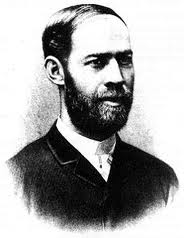-
(b.) -1857 February 22(d.)1894
Bio/Description
A German physicist who clarified and expanded the electromagnetic theory of light that had been put forth by Maxwell. He was the first to satisfactorily demonstrate the existence of electromagnetic waves by building an apparatus to produce and detect VHF or UHF radio waves. He was born in Hamburg, Germany, and while studying at the Gelehrtenschule des Johanneums in Hamburg, he showed an aptitude for sciences as well as languages, learning Arabic and Sanskrit. He studied sciences and engineering in the German cities of Dresden, Munich and Berlin, where he studied under Gustav R. Kirchhoff and Hermann von Helmholtz. In 1880, He obtained his PhD from the University of Berlin; and remained for post-doctoral study under Hermann von Helmholtz. In 1883, he took a post as a lecturer in theoretical physics at the University of Kiel and in 1885, he became a full professor at the University of Karlsruhe where he discovered electromagnetic waves. His experiments would soon trigger the invention of the wireless telegraph, radio, and later television. In recognition of his work, the unit of frequency - one cycle per second - is named the "hertz". His research from his days as a lecturer, preceding his great work on electromagnetism, which he himself considered with his characteristic soberness to be trivial, has come down to the age of nanotechnology. In 1886, he developed the Hertz antenna receiver. This is a set of terminals that is not electrically grounded for its operation. He also developed a transmitting type of dipole antenna, which was a center-fed driven element for transmitting UHF radio waves. These antennas are the simplest practical antennas from a theoretical point of view. His discoveries would later be more fully understood by others and be part of the new "wireless age". In bulk, his experiments explain reflection, refraction, polarization, interference, and velocity of electric waves. Among other honors bestowed upon him is a crater that lies on the far side of the Moon, just behind the eastern limb, which was named in his honor and the SI unit hertz (Hz) was established in his honor by the IEC in 1930 for frequency, a measurement of the number of times that a repeated event occurs per second (also called "cycles per sec" (cps)). It was adopted by the CGPM (Conf?rence g?n?rale des poids et mesures) in 1964.
-
Date of Birth:
1857 February 22 -
Date of Death:
1894 -
Gender:
Male -
Noted For:
The first to satisfactorily demonstrate the existence of electromagnetic waves -
Category of Achievement:
-
More Info:


